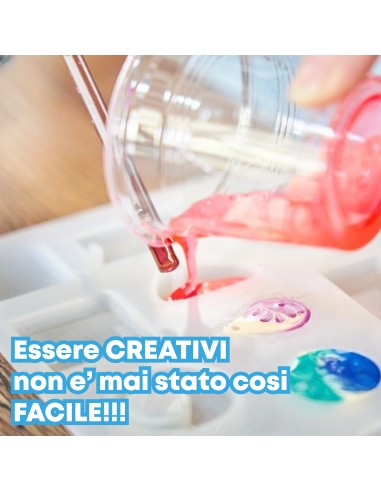Epoxy Resin Clear K-Diamond with Anti UV Filter 2-5cm
K-Diamond fast drying epoxy resin with UV filter for casting up to a maximum thickness of 1-2cm.
K-DIAMOND EPOXY RESIN FOR FAST CATALYSIS CASTING WITH ANTI-UV FILTER MAXIMUM THICKNESS FOR CASTING 1-2CM
Direct technical assistance 3342272665
Suitable for large and small jobs with low thicknesses, particularly suitable for super-glossy finishing of wood.
Two-component epoxy resin for casting on wood.
Specific product with fast catalyst that allows a touch drying in 12/24 hours at a temperature of 17/20 degrees centigrade.
The quick hardener only allows maximum castings from 1cm to 2cm depending on the total mass to be cast.
The K-Diamond epoxy resin is perfectly transparent and can be colored with our special concentrated dyes to obtain a transparent colored resin or colored with other effects such as pearls or metals.
PREPARATION OF THE SUBSTRATES
Make sure the wood is dry both internally and externally.
Insulate the wood with a water or solvent sealer to prevent the resin from emitting bubbles during the drying phase.
Sand the wood to have a perfect adhesion between wood and resin.
PREPARATION OF THE RESIN
Make sure you have a temperature of at least 17/18 degrees in your environment.
The resin catalyst works regularly above 17 degrees in a temperature range between 17 and 20 degrees centigrade.
If you cannot have this temperature then you must know that the drying time can be extended by over 12 hours compared to the times indicated in the following sheet.
Catalyze the resin only and exclusively by weight and never, never by volume, at 40%, translated into weight 100gr of base A + 40gr of base B.
RISKS AND PROBLEMS FOR RESIN
One of the greatest risks for the resin is constituted by the presence of cold and humidity.
The presence of water in the air is very dangerous because the resin absorbs water and the water causes two problems. The first is that the resin becomes opaque and the second is that the resin could dry out in a very long time, even taking 5/6 days. It is also possible that the resin never completely dries out.
So the choice to operate in the right conditions is fundamental.
SUGGESTIONS FOR A GOOD SUCCESS
To overcome the problems indicated, we suggest to all operators to do a very simple thing:
- Heat the paint cans separately from each other before mixing base and catalyst
- To do this, you can use a body shop heat gun without exaggerating the temperature and heating the cans all around, until the resin becomes clearer and more liquid
- Otherwise you can immerse the can in boiling water in a bain-marie and wait for it to heat up.
PREPARATION FOR CASTING
After having catalysed the resin in a ratio of 100 of base and 40 of catalyst, the two components are mixed well, possibly with an electric whisk applied to a screwdriver.
At this point a lot of air will enter the mixture and for this reason it will be good to leave the mixture to rest for 15/20 minutes before pouring it. In this way many bubbles will rise to the surface and can be removed before casting with the use of the heat gun.
IMPORTANT: Sometimes it happens that customers notice that the mass of cast resin dries in patches, that is, in some places it dries before and in others after, yet one wonders how this is possible? This happens because the catalyst and the resin have not yet entered into catalysis with each other and therefore the catalyst can be in contact with the humidity present in the air. By capturing this moisture the catalyst dries more slowly and sometimes no longer dries. To overcome this problem and be sure that the resin dries in the indicated times and above all in a perfect way, just do as follows:
1 mix the two components
2 wait for the bubbles to rise to the surface
3 break them with the help of our bubble-breaking sprays
4 wait a little longer until the jug containing the resin begins to heat up and becomes lukewarm. To make sure you don't make a mistake, you will need to carefully monitor the resin every 15 minutes, particularly if you are working with fast resin. As soon as you feel a minimum of heat emitted by the resin, start casting.
Now you are sure that the two components are in perfect catalysis with each other and nothing can affect the process.
This method is not always applicable as not everyone can stay there to monitor the resin but it is the best method to have a perfect job. So if you can follow this system always, for small and large castings. Watch out for castings in which masses of over 2/3 kilos are catalyzed as these masses quickly enter into catalysis, releasing a lot of heat at any moment, so the greater the catalyzed mass, the greater the attention you will have to pay to monitor this. mass. If you leave it unchecked for 30 minutes, for example, you may find yourself a solidified block that emits a lot of smoke and steam. So if you choose to use this technique, stay as close as possible to the resin to intercept the moment when the temperature begins to rise.
CASTING
The resin is simply poured into the support you have prepared or onto the support you have prepared.
It does not matter if you pour it from right to left or vice versa, being a self leveling product it will spread on its own in about an hour.
In both cases, you just need to pour the product and wait for the air to escape, helping yourself every 30 minutes with the aid of a heat gun to remove the bubbles on the surface.
Alternatively, you can use our bubble-breaking sprays. Special cans that contain a particular solvent that keeps the surface film of the resin to remain wet allowing the air contained in it to come out.
MULTIPLE CASTINGS
When pouring the resin the best thing for technical reasons is to pour layers of maximum 2cm at a time.
Obviously this rule does not apply if we have casting resin up to 5 or 10 cm even if we must always consider that such a high thickness depends on the total mass to be cast.
The greater the mass, the greater the heat developed, so it is not entirely true that 5 or 10 cm can always be poured, as if we pour such a high thickness we must know well what are the limits within which we can do it. let's talk more in depth in the section of 5cm and 10cm casting products.
If, on the other hand, we have to cast high thicknesses with 1cm resin we can do it by casting several layers in sequence. The important thing is to follow the following rules well:
1 pour a maximum of 2cm layers and test before letting it run. If we work on areas in square centimeters as small as 30 by 20 cm then we can pour 2 cm without problems but if we have to pour a table of 2 meters by one meter then more than 1cm we will not be able to pour.
2 We will have to perform the second casting only after the thickness has completely hardened, which will take place in 24 hours. We remind you that for a correct drying it is important that the ambient temperature should be possibly 17/20 degrees centigrade. We know that it is not always possible but if it were not the indicated times must be extended by 12 hours, so if we say to wait 24 hours it will be better to wait 36.
IF I MAKE MORE CASTINGS WILL I SEE DIFFERENCE BETWEEN THE LAYERS?
Absolutely not, if you respect the rule of always pouring a new layer on the perfectly hardened one, the connection between the two will never be seen and the final result will be perfect.
If, on the other hand, you have to pour colored resin, then to have a homogeneous layer you will have to color the entire mass of resin to be poured before catalyzing it, in this way you will have a single mass of the same color that you can catalyze from time to time without having the problem of layers. of different color.









